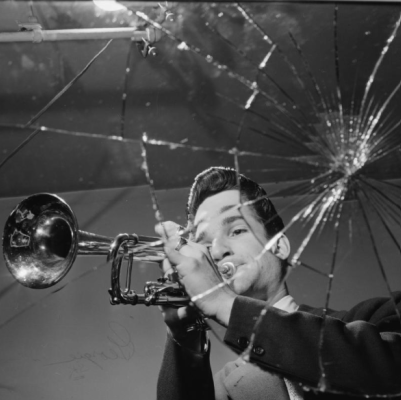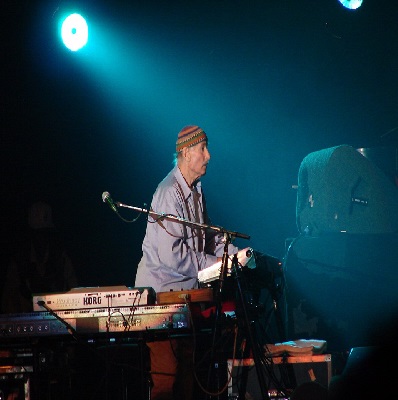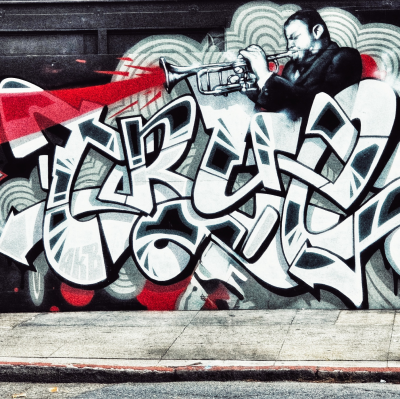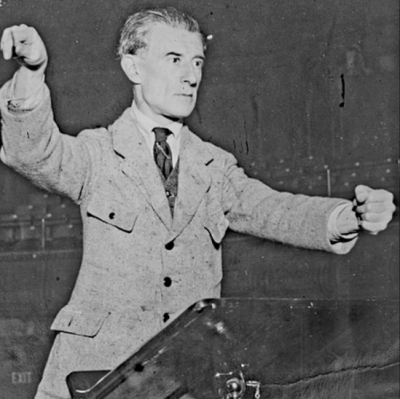American Popular Standards have become a vital part of our cultural heritage. They are the show tunes of Broadway and Hollywood, which – taken up by swing bands, jazz singers, and countless other performers of every description – were for decades the sound of popular music.
Crafted by such talents as Berlin, Gershwin, and Porter, and given voice by the likes of Sinatra, Holiday and Armstrong, the Standards continue to challenge each new generation of performers and listeners to master them, reinterpret them, and make them their own.
Max Morath, a highly acclaimed ragtime musician and recording artist for the Vanguard and SoloArt labels, is the author of The Road to Ragtime and contributor to Jazz: A Reader’s Companion. He has been heard on NPR’s Performance Today and has appeared on a number of public television specials.
The author of The NPR Curious Listener’s Guide to Popular Standards joins us in a lively conversation and provides a concise history of the art form commonly known as the “Standard.”
_________________________________________
JJM Who was your boyhood hero?
MM I had several heroes of different stripes. My musical hero when I was a kid was Art Tatum, and of course along with Tatum, my piano playing heroes were Fats Waller, Teddy Wilson, Billy Kyle, and by the time I was a teenager, Nat Cole. Because I started out as a physics, math and science maven, I was interested in people like Thomas Edison and Marconi, the founder of radio. That was one of the directions I was going until I got into this business.
JJM Define for me what a “standard” is.
MM It is a song, words and music, that every professional musician and singer is supposed to know. It is not totally generational, because the standards are not about nostalgia. The standards are about a body of music that has become, over the years, a genre – very much like opera or country or whatever. We can admit that the boundaries of the genre are slippery, but we can now look back and say there was a movement in the United States, in the mid-20th century, that produced a body of work of an indeterminate number of songs that every musician was supposed to know. When I was a kid, playing jazz, I would do jobs where a phone rings and on the other end is a leader that maybe you have never even worked with, who says , “Hey Max, can you play the Hilton hotel on Saturday night? It pays fifty bucks. Be there at 8:00. We have six guys.” So, you show up and you don’t know these people – never worked with them before. The leader gets up and says, “Okay, lets open up with “I Got Rhythm,” we’ll do it in ‘C’, and then if we want to do a vocal we’ll bring it into ‘A’ flat.” Now, you’d better know the chord progression, you’d better know the melody, you’d better know where to go, or you’re not going to get called again. That’s a standard. That body of work, as we look back, was the result of not too many composers and songwriters – maybe a couple dozen major people – the Gershwin Brothers, Irving Berlin, Harold Arlen, Hoagy Carmichael, Richard Rogers, and others. They worked approximately from the period of 1920 to 1960, give or take a few years on each side, creating this standard body of work that we now call the “popular standard.”
JJM How many songs do you consider to be standards?
MM I think that would have to be subjective. In the book we limited it to 100. A lot of people have asked, “Those are the only 100?” Of course not. Ten other musicians would write down 200 others, and we would overlap on maybe 25 of them. There are several thousand that could be called standards if they fit the qualifications I just described – that is you better know them.
JJM In retrospect is there a song that you wish you had suggested as a standard among your 100?
MM Well, I am sure there is. I am not sure I could put my finger on it. There were some Harold Arlen songs, for instance, that I have loved all my life and thought afterwards that maybe should have been included. We did the book in almost two years, and I started out with about 215 of them, and in the first edit cut it to 150. When the final edit went to print there were 100, and we just decided that it had to be somewhat subjective. Sure, maybe there were a dozen of those that are “Max Morath favorites” and no other musician would necessarily put them in. But there were certainly others, too, that would be on anybody’s list, “Stardust,” “Body and Soul,” “Night and Day,” “Blue Skies,” “Always,” “Ain’t Misbehavin'”.
JJM These great tunes came from a variety of different sources, notably musical theater, Broadway and movies. What is Tin Pan Alley?
MM Tin Pan Alley is one of those expressions, that is used similarly to how we say “Wall Street.” when referring to the financial business. We say “Silicon Valley,” and that means the computer business. We say “Tin Pan Alley,” and for a certain period of time from about 1890 to about 1930, it meant the New York music publishing game. The term “Tin Pan Alley” was supposedly coined in 1905 by a songwriter who was looking out his window on 28th street, where all the publishers were, and heard all these lousy pianos playing different tunes on a summer afternoon . He said the noise sounded like tin pans. I don’t know whether that is true or not, but it is a good story. Therefore, it became one of those terms that became generic. If you said “Tin Pan Alley,” you were supposed to know that it meant the New York publishing game. “Tin Pan Alley” meant a song that was written for the market place. It is one of the things I find very interesting about these composers in this world. These people were pros. They were not writing for their own voices, they were writing for the marketplace. If it was a vaudeville act and someone asked for an uptempo tune, the composer would write something. Or, the songwriter could have been sitting in a cubical over here on 14th street or 42nd street, writing a tune, and he takes it out and sells it as if he was in any business. He is selling product.
JJM What is a famous Tin Pan Alley song?
MM There are not very many in the book, although there was a tremendous amount of overlap. Irving Berlin, who was a figure on Tin Pan Alley, was also writing for reviews for musicals and later, of course, for films. “It Had to Be You” was not from a show, from a musical or from a film.
JJM Tin Pan Alley songs were basically manufactured either for vaudeville or sheet music sales…
MM Yes, the marketplace. Like kids today, they do an album, they put it on the market, and hope something happens. American popular music is essentially a business, and one of the things I tried to put in the book is how economics and technology have been driving the music, theatre, print and film business since the beginning of the 20th century. Each generation comes along and writes and composes and creates for the world they came into. The world that these people came into was the beginning of the phonograph, the beginning of the radio, and by the 1930’s the beginning of sound on film. Three major breakthroughs that started out as technological breakthroughs, and then became tremendous economic forces.
JJM Popular standards and radio actually shared “golden years,” didn’t they?
MM Yes, they sure did, in addition to movie musicals. The first movie musical broke through around 1930 when sound on film began to be perfected. The movie musicals pretty much died in the mid 1950’s. Irving Berlin and Harry Warren and those guys worked within the technology and the economics of their own time. You look at the biographies of the New York songwriters, and half of them, it seems, were on the Santa Fe trains headed for Los Angeles in 1930, and they stayed there. This is what happened to Harry Warren, Hoagy Carmichael, and Walter Donaldson. George Gershwin hated California, but he’d go out and do a couple of movies and then come back and do Broadway. Berlin would go out and do a couple of Fred Astaire flicks. It was quite a world! I can’t emphasize too much that these writers were craftsmen, this was their job. Richard Rodgers was once asked, “Why don’t you quit?” Rodgers replied, “It’s my job. What else am I going to do?”
JJM You devote a chapter in your book to the songwriters, and the likes of Irving Berlin, Cole Porter, Jerome Kern, and Richard Rodgers dominate the list when it comes to standards. Was there a “one hit wonder” composer who made the list by virtue of the strength of his or her one famous standard?
MM Well, I think that there were several. For instance, “Tenderly,” was a massive, beautiful standard that came along in 1946. The lyricist was Jack Lawrence, who was a pretty well known guy, and the pianist and composer was Walter Gross, who was certainly well known in the business, a wonderful pianist and accompanist, but he didn’t have a string of hits. This one was his big hit. Same way if you think about it with “Fly Me to the Moon,” which started out under a different title, “In Other Words.” Bart Howard, wrote that tune – words and music – in 1954. He was a pianist well known around New York as an accompanist to Mabel Mercer who had this one big hit. But that is the exception to the rule. Most of the others were people like Hoagy Carmichael and Cole Porter and Harry Warren, who turned songs out year after year and they were blessed, most of them, with longevity. Another tune is “When Your Lover Has Gone,” which has been done by Miles Davis, Carly Simon, Dave McKenna It was written by a guy named Einar Swan in 1931, and he died at the age of 36. Well, who knows what he might have done? He was very active here in New York, he was in the radio business, the phonograph business. Sure, there were a few breakthroughs but basically songwriting was a life long game.
JJM Dorothy Fields was one of the few female composers. How did her style differ from her male counterparts?
MM In the first place, I can certainly say that Dorothy Fields’ lyrics were frankly a hell of a lot better than many of the others. She somehow had a feel for idiom and getting just the right phrase in just the right place. “I Can’t Give You Anything But Love,” “I’m in the Mood for Love,” “The Sunny Side of the Street.” Irving Berlin once said, “If you want to write a successful song, think of a new way to say ‘I love you’.” When you look at the standards, 75 to 80 percent of them are love songs. They explore the various attitudes of romantic love, about finding it, losing it, having the blues over it, being elated over it. “On the Sunny Side of the Street” is a way to say it. Fields was a total pro. She was writing until the last year of her life. She and her brother, Herbert, wrote the book for “Annie Get Your Gun,” and that was towards the end of her life. This was another professional who found good partners, worked with a number of other composers, and had a wonderful touch. She came from a show business family – her dad was Lou Fields, one of the great vaudevillians and producers, and a major force in show business for 30 years. So, she grew up with it.
JJM Talk a little bit about Irving Berlin, and what he meant to American music.
MM You have to say several things about Berlin. One is that he was the over-arching master of the form. He changed with the times. Many other composers of his generation who wrote for Tin Pan Alley really couldn’t change their style. Some of them were very prolific. Charles K Harris, for example, probably wrote more songs than anybody. Who has ever heard of any, except for “After The Ball Is Over”? They didn’t change but Berlin changed. He got into the twenties and started writing for the theaters. He got into the thirties and wrote for Astaire and Rogers in film. In the forties and fifties he wrote for the big musicals. So, that is the first thing you have to say about him, that he stayed in there. He lived to be 101, and his career was a good seventy years of productivity. Another thing you must say about Berlin is that he was the best businessman of the composers. By the time he was 25 years old, he had a major publishing company and he owned every word and note that he wrote. That is very unusual in this business. Berlin owned his own work! We have all heard the horror stories about how composers had a hit record twenty years ago and now they don’t have a nickel. Not true of Berlin, he controlled his own work. A lot of people would say, “He must have been a tough old man.” You bet he was. He wrote songs that I know came right from his soul, from his heart. He was very opinionated, very tough, knew exactly what he wanted to say, and he was always extremely generous. I just think that he was the master.
JJM How was Duke Ellington’s style of composing different from other composers of his era?
MM I am glad you are going in the direction of jazz because that is very important. Ellington, of course, was a real renaissance man, as a pianist and as a composer. He had immense talent. Many people say that Ellington used his orchestra as his compositional medium. Other people sat down and wrote vaudeville specialties or reviews or film scores, but Ellington, for more years than most, had a working orchestra with the same musicians. Out of all that massive body of Ellington’s work, a number of standards did emerge. “Sophisticated Lady,” “Satin Doll,” “Take The A Train,” and many others. I think as the years go by, we are going to look back more and more at his non-standards and big instrumental work. They will be compared to Gershwin’s “Rhapsody Blue” or “American In Paris,” – big works for orchestra that were not standards, that did not have words, but were marvelous compositions for that kind of orchestra and that time and place. We will be going back to them as the years go by. “Satin Doll” and “Take the ‘A’ Train,” by the way, started out as band pieces, and along came some lyricists, one of whom was Johnny Mercer, who wrote the lyrics to “Satin Doll.” This is not easy! You take a song that was written as a jump tune and sit down and try to write words to it, and this is not easy. A lot of Ellington’s things did start out as band pieces, which is unusual. Another song of that type is “Misty,” which was composed by Errol Garner as a piano piece, but he had a big hit on it instrumentally. Then along came Johnny Burke, who wrote that marvelous lyric to “Misty.” Ella Fitzgerald picked it up and it became a big vocal hit. But this is highly unusual, it isn’t something that happens all the time.
JJMWhat about the intersection of standards and jazz?
MM We wouldn’t have the standards if we didn’t have this music called jazz. They both surfaced in the early 1920’s. The repertoire of jazz musicians to this day is basically the standards. It was certainly true through the thirties, forties and fifties, and if you look closely at the tunes that are being played by this great young generation of jazz musicians who are all in their late thirties these days – Wynton Marsalis, Scott Hamilton, Howard Alden – they play the standards. They come back to the standards for reasons that are identifiable but also mysterious. Why did the great icon of trumpet players, Miles Davis, record so many standards? The man’s style was anything but the style of film music or Broadway music, but he went back to the standards over and over because they attracted him and they challenged him. This is what happens with a jazz musician. They come upon a tune, and they don’t care if it was in a Fred Astaire movie or one that Judy Garland sang in 1938. They look at the tune and think about chord progression and hear open space where they can do a riff. This is what brought the jazz musicians to the standards. Often, Louis Armstrong is credited with having been one of the first to take a pop tune like “I Can’t Give You Anything But Love,” and not play exactly what the songwriter wrote. He stated it maybe once, then he would go have some fun with it, and then the trombone player is going to do it, and then the clarinet player takes half a chorus, and then it’s the pianist’s turn. Then they put it back together and do an out-chorus on the melody.
JJM Would song standards have even survived mid-century if not for the act of collaboration of the jazz performers of the day?
MM There is no question about that. But here is one of the things I said was mysterious and something I don’t have an answer to. When we go back to the fact that 98% of what we are calling the standards were vocal music, how come the life that was given to them by the jazz musicians was non-vocal but instrumental? Oscar Peterson has recorded every standard that you have ever heard of. So has Errol Garner. Miles Davis recorded dozens of standards. The great reed players like Coleman Hawkins and Lester Young did as well. The contemporary guys are doing the same thing. Now, there a new things coming along, sure, but how come they went back to a body of work that is essentially to be sung, and then used it as vehicles for instrumental work? I don’t know the answer to that, I can only say that it has something to do with the fact that in the United States during mid-century, some very strange and wonderful things were happening. Jazz intersected the standards, yet with the exception of Ellington and Hoagy Carmichael and one or two others, the composers weren’t jazz musicians, they were Broadway musicians. Richard Rodgers didn’t even like jazz. Berlin was not a musician. He was a wonderful composer but he just played a little bit of piano. He didn’t have any idea that the jazz musicians would take to his tunes but they did.
JJMThe bassist Charles Mingus was also an incredible composer. Yet, his jazz musician contemporaries seemed much more willing to go back and do standards by the likes of Carmichael, Cole Porter and Richard Rodgers. Why?
MM I would have to say in the first place that Mingus’ compositions are very difficult, very idiosyncratic, and they don’t have any words that I know of.
JJM But if you are a jazz musician, you don’t necessarily need any words, you only require a melodic theme you could then improvise on
MM Yes. See, Mingus’ work is filled with notes and you are supposed to play them. Now the essence of the jazz musician, his approach to his piece of music is “I am going to do what I want to do.” You know, Mingus was great, but musicians would prefer playing a tune like “Blue Skies” because they had a great idea for a counter melody, and they wanted to play it their way. Jazz is all about persona. Doing what you want to do. You have to have a matrix within which to do it. That is where I think the standards came in and still exist, and that is one of the reasons that they are going to be around for a long time.
JJM Is there a standard that is recorded by the most eclectic array of artists?
MM Well, certainly you would have to go to “Stardust,” which has been recorded by everybody, including Willie Nelson. “Blue Skies,” an Irving Berlin tune, has been recorded by a wide range in every discipline. Tom Waits, Dr. John, Riders In The Sky, Ben Webster, Red Norvo, Frank Sinatra, Ella Fitzgerald, Tommy Dorsey, Count Basie, Crosby, Stills and Nash On Berlin’s “Cheek to Cheek,” Pete Fountain, Dick Hyman, Doris Day, Peggy Lee. On “Georgia on My Mind,” which is a great Carmichael tune, you have Michael Bolton, Willie Nelson, Gladys Knight, Ray Charles, Floyd Cramer, and Mildred Bailey, bless her heart, the unsung hero of the thirties, who did so much for standards. You just touched on exactly what we are trying to say here and that is a standard is language that everybody wants to adopt and make their own. Did Willie Nelson sing “Blue Skies” like Crosby Still and Nash? No of course not. He imprinted it with his own style.
JJM Given the nature of today’s popular music, for example, that it is generally lacking in melody, what special challenges do modern day Broadway writers face? In other words, to appeal to a younger audience who grows up with rhythmic based music and one seemingly programmed with shorter attention spans, what kind of challenges do Broadway writers have?
MM Well, Broadway writers are trying to sound like Andrew Lloyd Weber. That is ok, there has always been a leader. The greatest living Broadway composer is Stephen Sondhiem, who has set a whole new set of parameters for what is good on Broadway. His is a very broad, extensive, literate kind of music. Our music and our popular culture is always generational. There is no reason why every generation should love what the last generation did. The things that last, the separating of the weak from the strong are good things. Nobody could even remember Scott Joplin for eighty years until he was finally rediscovered. I think that the kids today or even in the last twenty or thirty years have been in a different musical world. As we said earlier, they answered to the technical and economic demands of their time. I have always figured rock and roll would not have started without multi-track tape and semi-conductors. It had to be a studio sound and that couldn’t have happened until we had those technological breakthroughs. The kids starting in the sixties started to write for that market place. One of the big things that happened, and one of the things that helped us to delineate the early sixties as sort of the ending point of the standards, was that the next generation – led by the Beatles, Bob Dylan, the Rolling Stones, James Taylor, and Carole King – were writing for themselves, very personal things. They were making statements. Dylan certainly is the outstanding example of that. They weren’t writing for the market place. Bob Dylan wasn’t writing for some other act to come on and sing his song. No, they were up front with their idea. The singer/composer became what we look back on as the music of the last thirty to forty years. It is an entirely different kind of strategy, nothing less or more talented by those people than the ones that preceeded them. But they wrote for a different market. Today, the pop world is so splintered. You look in the trade magazine and there are separate sections for all these different splintered groups of country, hard rock, rock, soft rock, jazz, light jazz, and all of those things. Kids starting out today, it is tough, it has always been tough but now it is tougher.
JJM What is the most famous standard in your estimation?
MM Hoagy Carmichael’s “Stardust,” just in terms of the highest number of recordings over the longest number of years, no question.
JJM What is your favorite standard?
MM My favorite? Oh gosh, it changes every day, and I still sit and play them for fun. One of my favorite standards is “Over The Rainbow.” It is one of those things that you play endlessly and don’t know why. Yeah, I will go for that one, for right now.
JJM Is it hard to separate out Judy Garland’s recording of it when you play it?
MM Oh no, I don’t hear her voice when I play it at all. It is a beautiful chord progression, challenging to improvise on partly because it has some big open spaces.
JJM In your opinion, what is the ultimate recording of a standard?
MM Gee, that is tough. I would have to say, just pulling one out of the air, a recording which shows the nature of the standard, I would go back to when Streisand, in about 1963, took an uptempo depression song called “Happy Days Are Here Again,” and put a jazz feel to it and slowed it down about a factor of five-to-one, and had a hit record. I mean that is just one, the one that first came to my mind. That helped make her career, by the way. It was a breakthrough, it was a great idea and she delivered it beautifully.
_______________________________
The NPR Curious Listener’s Guide to Popular Standards
by
Max Morath
________________________________
Max Morath products at Amazon.com
_______________________________
Interview took place on June 5, 2002
*
If you enjoyed this interview, you may want to read our interview with conductor, composer Loren Schoenberg











































